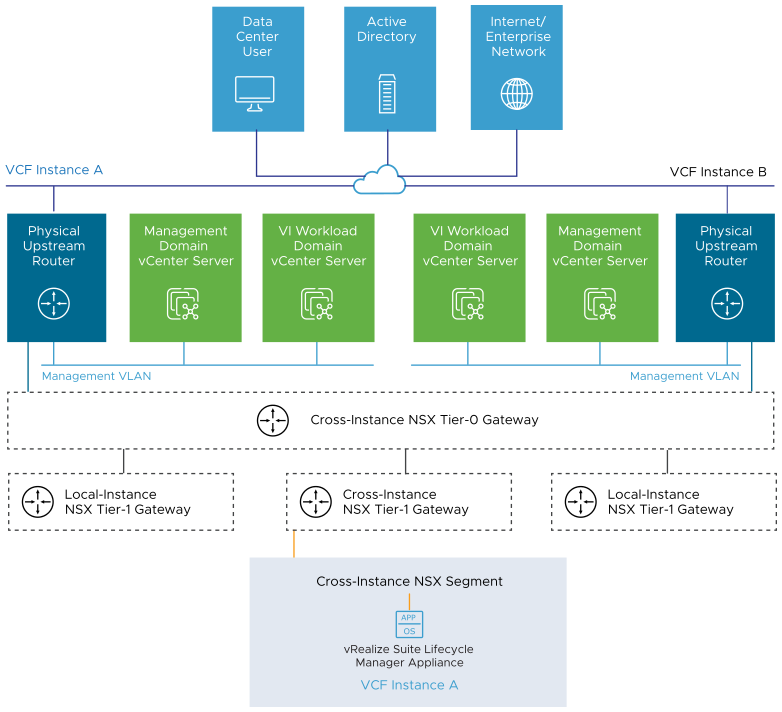For secure access to the UI and API, you place the vRealize Suite Lifecycle Manager appliance on an overlay-backed or VLAN-backed NSX segment.
Network Segments
For secure access to the application UI and API, the vRealize Suite Lifecycle Manager appliance is connected to an NSX segment that is overlay-backed (recommended) or VLAN-backed.
This network design has the following features:
vRealize Suite Lifecycle Manager has routed access to the management VLAN through the Tier-0 gateway in the NSX-T Data Center instance for the management domain.
Routing to the management VLAN, NSX segments, and external networks is dynamic and is based on the Border Gateway Protocol (BGP).

Decision ID |
Design Decision |
Design Justification |
Design Implication |
|---|---|---|---|
VCF-VRS-vRSLCM-NET-001 |
Place the vRealize Suite Lifecycle Manager appliance on an overlay-backed (recommended) or VLAN-backed NSX network segment. |
Provides a consistent deployment model for management applications. |
You must use an implementation in NSX-T Data Center to support this networking configuration. |
IP Addressing Scheme
Allocate a static IP address from the NSX segment to the vRealize Suite Lifecycle Manager appliance.
Decision ID |
Design Decision |
Design Justification |
Design Implication |
|---|---|---|---|
VCF-VRS-vRSLCM-NET-002 |
Allocate a statically assigned IP address and host name to the vRealize Suite Lifecycle Manager virtual appliance. |
Using statically assigned IP addresses ensures stability across the SDDC and makes it simpler to maintain and easier to track. |
Requires precise IP address management. |
Name Resolution
The IP address of the vRealize Suite Lifecycle Manager appliance is associated with a fully qualified domain name whose suffix aligns with your domain name, and must have valid DNS forward (A) and reverse (PTR) records.
Decision ID |
Design Decision |
Design Justification |
Design Implication |
|---|---|---|---|
VCF-VRS-vRSLCM-NET-003 |
Configure forward and reverse DNS records for the vRealize Suite Lifecycle Manager appliance. |
vRealize Suite Lifecycle Manager is accessible by using a fully qualified domain name instead of by using the IP address only. |
You must provide DNS records for the vRealize Suite Lifecycle Manager appliance. |
VCF-VRS-vRSLCM-NET-004 |
Configure the DNS settings for the vRealize Suite Lifecycle Manager appliance to use DNS servers from its corresponding VMware Cloud Foundation instance. |
vRealize Suite Lifecycle Manager requires DNS resolution to connect to SDDC Components. |
None. |
Name Resolution for Multiple VMware Cloud Foundation Instances
Multiple DNS servers are available across the instances, providing higher DNS availability and resilience.
Decision ID |
Design Decision |
Design Justification |
Design Implication |
|---|---|---|---|
VCF-VRS-vRSLCM-NET-005 |
Configure the DNS settings for the vRealize Suite Lifecycle Manager appliance to use DNS servers in each instance. |
vRealize Suite Lifecycle Manager can resolve DNS from local DNS servers during a planned migration or disaster recovery between VMware Cloud Foundation instances. |
As you scale from a deployment with a single VMware Cloud Foundation instance to one with multiple VMware Cloud Foundation instances, the DNS settings the vRealize Suite Lifecycle Manager appliance must be updated. |
Time Synchronization
vRealize Suite Lifecycle Manager depends on time synchronization.
Decision ID |
Design Decision |
Design Justification |
Design Implication |
|---|---|---|---|
VCF-VRS-vRSLCM-NET-006 |
Configure the NTP settings for the vRealize Suite Lifecycle Manager appliance to use NTP servers in the first VMware Cloud Foundation instance. |
vRealize Suite Lifecycle Manager depends on time synchronization. |
None. |
Time Synchronization for Multiple VMware Cloud Foundation Instances
Multiple NTP servers are available across the instances, providing higher NTP availability and resilience.
Decision ID |
Design Decision |
Design Justification |
Design Implication |
|---|---|---|---|
VCF-VRS-vRSLCM-NET-007 |
Configure the NTP settings for the vRealize Suite Lifecycle Manager appliance to use NTP servers in each VMware Cloud Foundation instance. |
vRealize Suite Lifecycle Manager can query NTP from local NTP servers to synchronize time during a planned migration or disaster recovery between the VMware Cloud Foundation instances. |
As you scale from a deployment with a single VMware Cloud Foundation instance to one with multiple VMware Cloud Foundation instances, the NTP settings on the vRealize Suite Lifecycle Manager appliance must be updated. |